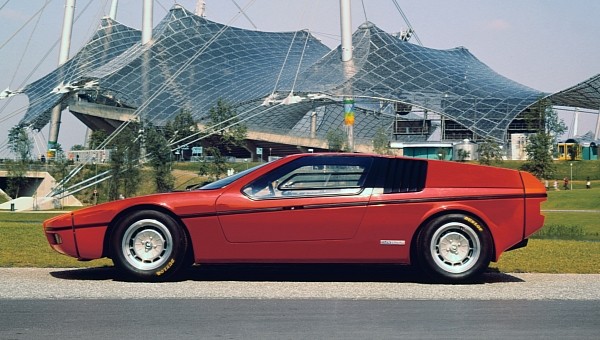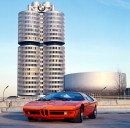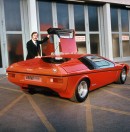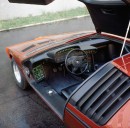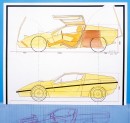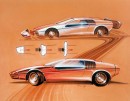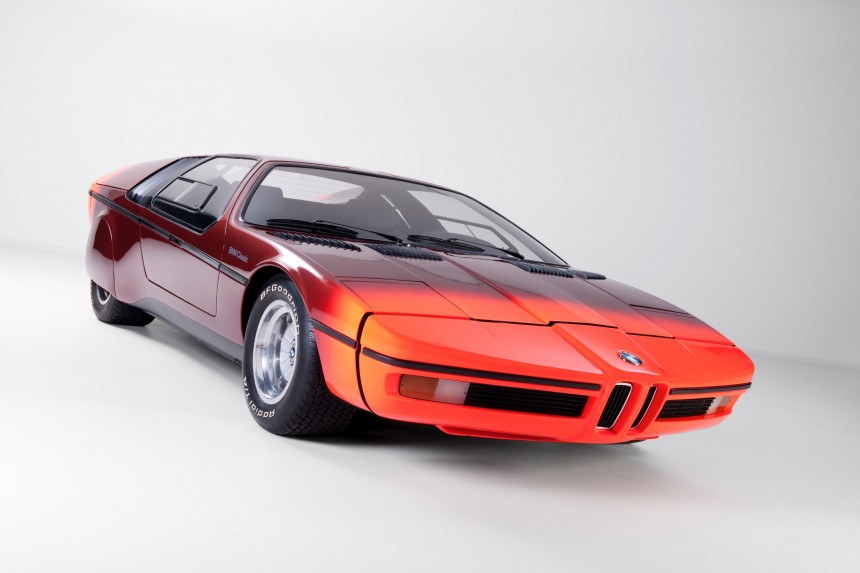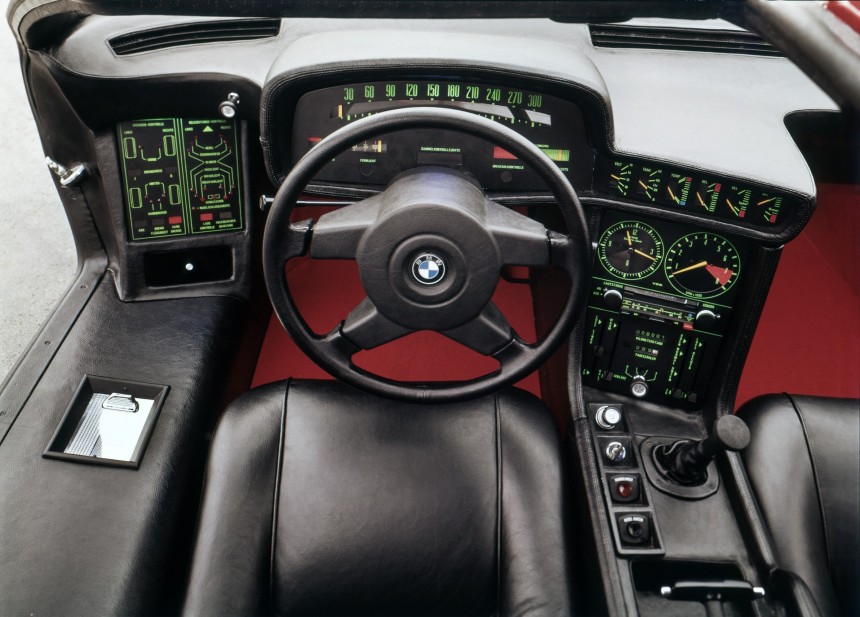One of the most celebrated automotive designers of all time, Paul Bracq, is the gentleman responsible for many elegant cars. During his tenure at BMW, the French designer penned the likes of the first-generation 3, 5, 6, and 7 Series. Appointed design director in 1970, this kind gentleman is further credited with the Bavarian company’s wildest design of the ‘70s.
It's nigh-on impossible to separate the automaker’s first-ever concept car from the M1, which arrived six years after this design study with Italdesign cues by Giorgetto Giugiaro. You can also notice how intertwined these cars are by means of their codenames: E25 for the Turbo and E26 for the M1.
Rather than outright sportiness, this incredible-looking machine was designed specifically to demonstrate that a safe car didn’t have to be ugly. For a bit of context, U.S. federal regulations announced in 1971 for the 1973 model year mandated ugly bumpers. Cars fitted with said bumpers had to survive a frontal collision at five miles per hour (eight kilometers per hour) and a rear impact at 2.5 mph (4.0 kph) without any sort of damage to critical safety-related components and systems (i.e., headlamps and fuel system).
The wedge-shaped automotive icon features both active and passive safety bits and pieces, including foam-filled front and rear sections mounted on hydraulic struts. The skinny A-pillars enable good visibility out of the ginormous front and side windows. An integrated roll cage, side impact beams, and crumple zones also need to be mentioned, along with a radar-based brake distance warning system that can be considered a precursor to active cruise control. Said system shows the driver the distance to the vehicle in front via a display. In the event the distance falls below a certain level, the driver is alerted by audible warnings to step on the brake pedal.
Bracq and his team had even considered the location of the pop-up headlights, mounted right behind the front bumper so that they wouldn’t be damaged in case of a low-speed collision. Equipped with anti-lock brakes a whopping six years before ABS premiered in BMW’s lineup with the rollout of the first-generation 7er (E23), the Turbo also integrates a lateral acceleration sensor. In other words, the Turbo can also be considered the basis for the traction control system of the second-generation 7er (E32).
As if the aforementioned weren’t sufficiently impressive for that era, the Turbo further boasts a steering wheel featuring three universal joints. The gullwing-door sports car is also equipped with a check control function. Made possible by a fiber optic system, check control is designed to inform the driver of the oil level, brake fluid, coolant, brake pad wear, and brake bulb operation. A four-wheel trailblazer, the Turbo premiered at the 1972 Paris Motor Show in the guise of a static display car. Not much later, Giovanni Michelotti’s outfit would build a second fully-functioning car.
A test bed for new technologies, the E25 doesn’t feature a unique platform. It’s built around the steel chassis of the 02 Series that gave us the marvelous 2002 Turbo, codenamed E20. Speaking of which, care to guess what engine hides under the hood? Of course, it’s a turbocharged version of Alex von Falkenhausen-developed M10. Internally referred to as M31, the 2002 Turbo engine rocks the same bore and stroke as the M15 in the 2002 Tii.
Tipping the scales at 1,272 kilos (2,804 pounds), the Turbo measures 4,155 millimeters (163.6 inches) front to rear. 1,100 millimeters (43.3 inches) tall and 1,880 millimeters (74 inches) wide, this concept features a 2,400-mm (94.5-in) wheelbase as opposed to 2,500 mm (98.4 in) for the 2002 Turbo.
Equipped with semi-trailing arms out back and MacPherson struts in the front, the Turbo rides on 14- by 9.5-inch wheels mounted with Dunlop rubber boots. Although it’s hard to tell from certain angles, the front track is wider than the rear track (1,550 versus 1,530 millimeters or 61 versus 60.2 inches). The predecessor of the M1 uses Bosch Kugelfischer mechanical fuel injection and supplementary oil cooler of the 2002 Turbo, as well as a four-speed manual box supplied by German company Getrag.
Gifted with a limited-slip rear differential from ZF, the Turbo runs the same 6.8:1 compression ratio as the 2002 Turbo. BMW quotes 280 ps (276 hp) in this application versus 170 ps (168 horsepower) and 240 Nm (177 pound-feet) of torque at 7 pounds per square inch in the 2002 Turbo. The 1-3-4-2 firing order of the 2.0L four-pot engine is obviously shared as well.
Boosted like crazy, the Turbo is much obliged to reach 100 kilometers per hour (62 miles per hour) in 6.6 seconds. Top speed? That would be 250 kilometers per hour (155 miles per hour), which is genuinely impressive for a ‘70s four-cylinder mill connected to a stick shift with four forward ratios. For reference, the sixth-gen Chevrolet Camaro with the standard 2.0L turbo can stretch its legs to 240 kilometers per hour (nearly 150 miles per hour).
Visually distinct from any prior Bimmers, the Turbo is easily identifiable as a BMW thanks to its kidney grilles. One of the most underrated aesthetic traits of the E25 comes in the guise of matte-black cooling vents behind each side window, which are joined by matte-black side window garnish. The convex engine cover is pretty cool as well, as is the futuristic interior.
The first driver-focused interior ever designed by the Munich-based automaker is upholstered in black, whereas red-ish carpets match the exterior paint color. Also worthy of note, the Turbo is equipped with an inhibitor switch that doesn’t allow the engine to start if the driver and passenger don’t buckle up. Serving as inspiration for the first-gen 8er and Z1 as well, the Turbo lies dormant in Munich at the BMW Museum. The other car can be found at BMW Zentrum in Spartanburg, South Carolina.
Rather than outright sportiness, this incredible-looking machine was designed specifically to demonstrate that a safe car didn’t have to be ugly. For a bit of context, U.S. federal regulations announced in 1971 for the 1973 model year mandated ugly bumpers. Cars fitted with said bumpers had to survive a frontal collision at five miles per hour (eight kilometers per hour) and a rear impact at 2.5 mph (4.0 kph) without any sort of damage to critical safety-related components and systems (i.e., headlamps and fuel system).
The wedge-shaped automotive icon features both active and passive safety bits and pieces, including foam-filled front and rear sections mounted on hydraulic struts. The skinny A-pillars enable good visibility out of the ginormous front and side windows. An integrated roll cage, side impact beams, and crumple zones also need to be mentioned, along with a radar-based brake distance warning system that can be considered a precursor to active cruise control. Said system shows the driver the distance to the vehicle in front via a display. In the event the distance falls below a certain level, the driver is alerted by audible warnings to step on the brake pedal.
Bracq and his team had even considered the location of the pop-up headlights, mounted right behind the front bumper so that they wouldn’t be damaged in case of a low-speed collision. Equipped with anti-lock brakes a whopping six years before ABS premiered in BMW’s lineup with the rollout of the first-generation 7er (E23), the Turbo also integrates a lateral acceleration sensor. In other words, the Turbo can also be considered the basis for the traction control system of the second-generation 7er (E32).
A test bed for new technologies, the E25 doesn’t feature a unique platform. It’s built around the steel chassis of the 02 Series that gave us the marvelous 2002 Turbo, codenamed E20. Speaking of which, care to guess what engine hides under the hood? Of course, it’s a turbocharged version of Alex von Falkenhausen-developed M10. Internally referred to as M31, the 2002 Turbo engine rocks the same bore and stroke as the M15 in the 2002 Tii.
Tipping the scales at 1,272 kilos (2,804 pounds), the Turbo measures 4,155 millimeters (163.6 inches) front to rear. 1,100 millimeters (43.3 inches) tall and 1,880 millimeters (74 inches) wide, this concept features a 2,400-mm (94.5-in) wheelbase as opposed to 2,500 mm (98.4 in) for the 2002 Turbo.
Equipped with semi-trailing arms out back and MacPherson struts in the front, the Turbo rides on 14- by 9.5-inch wheels mounted with Dunlop rubber boots. Although it’s hard to tell from certain angles, the front track is wider than the rear track (1,550 versus 1,530 millimeters or 61 versus 60.2 inches). The predecessor of the M1 uses Bosch Kugelfischer mechanical fuel injection and supplementary oil cooler of the 2002 Turbo, as well as a four-speed manual box supplied by German company Getrag.
Boosted like crazy, the Turbo is much obliged to reach 100 kilometers per hour (62 miles per hour) in 6.6 seconds. Top speed? That would be 250 kilometers per hour (155 miles per hour), which is genuinely impressive for a ‘70s four-cylinder mill connected to a stick shift with four forward ratios. For reference, the sixth-gen Chevrolet Camaro with the standard 2.0L turbo can stretch its legs to 240 kilometers per hour (nearly 150 miles per hour).
Visually distinct from any prior Bimmers, the Turbo is easily identifiable as a BMW thanks to its kidney grilles. One of the most underrated aesthetic traits of the E25 comes in the guise of matte-black cooling vents behind each side window, which are joined by matte-black side window garnish. The convex engine cover is pretty cool as well, as is the futuristic interior.
The first driver-focused interior ever designed by the Munich-based automaker is upholstered in black, whereas red-ish carpets match the exterior paint color. Also worthy of note, the Turbo is equipped with an inhibitor switch that doesn’t allow the engine to start if the driver and passenger don’t buckle up. Serving as inspiration for the first-gen 8er and Z1 as well, the Turbo lies dormant in Munich at the BMW Museum. The other car can be found at BMW Zentrum in Spartanburg, South Carolina.
